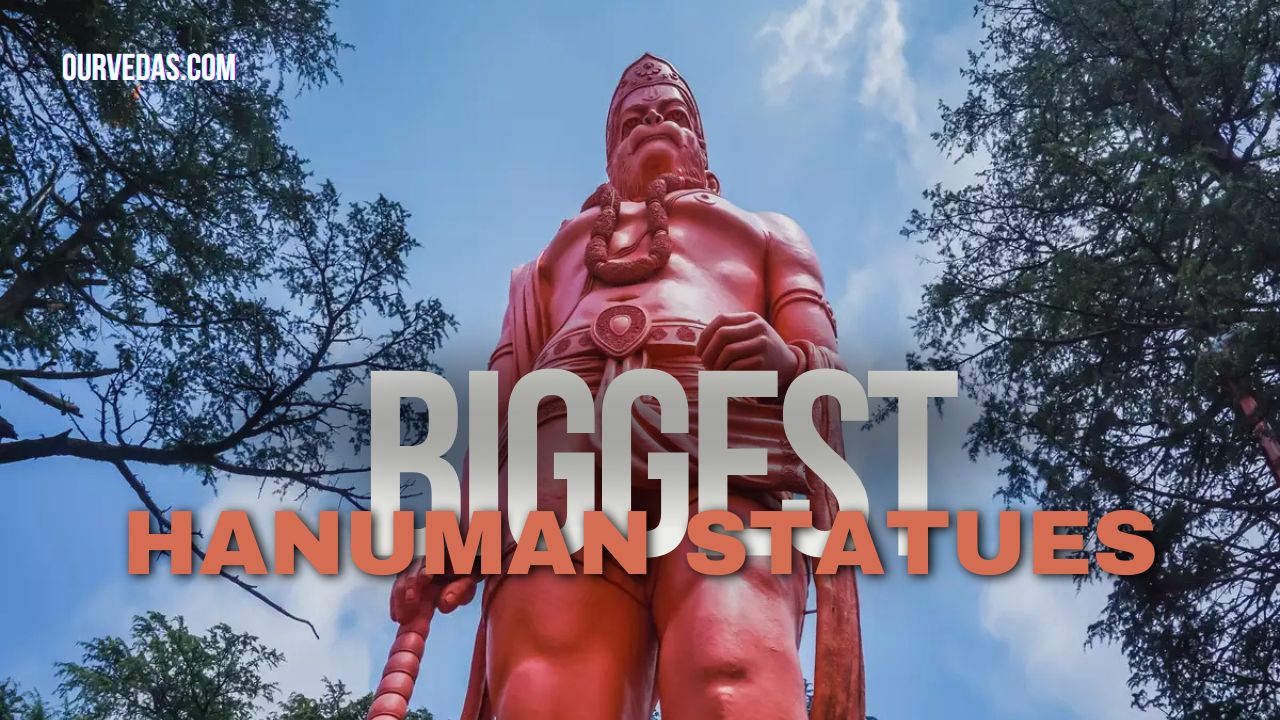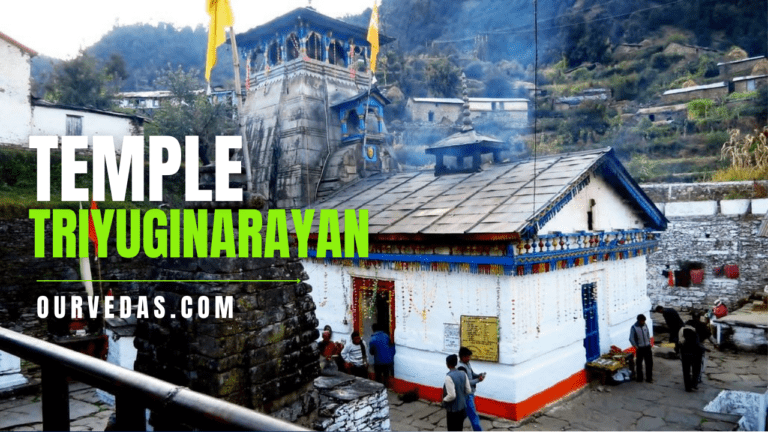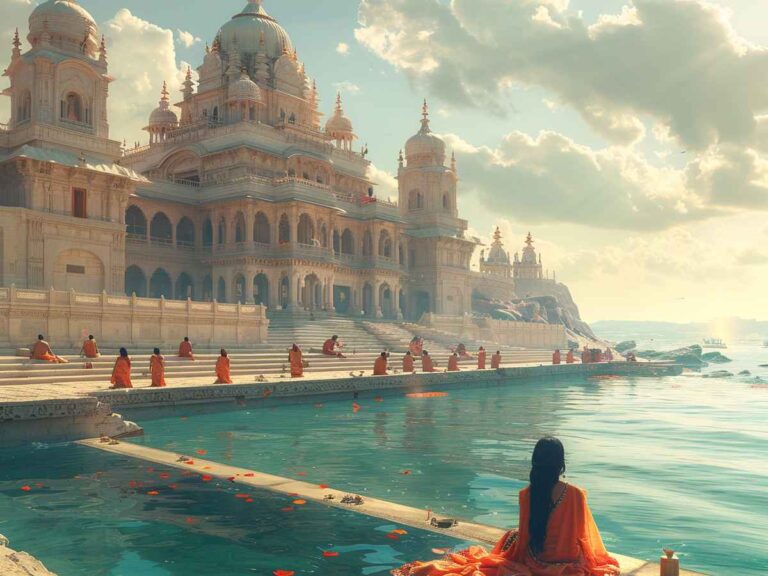Biggest Hanuman Statues in India: A Colossal Journey Through Faith
The iconic figure of Hanuman, revered as a symbol of strength and devotion, holds a special place in the hearts of millions across India. His tales of loyalty and bravery have transformed into a deep-seated devotion that manifests itself in stunning statues. These monumental structures are not just artistic creations; they represent a rich cultural heritage and spiritual significance. This article will explore the largest Hanuman statues in India, showcasing their architectural wonders, historical importance, and the spiritual journeys they inspire.
Who Is Hanuman? The Mighty Monkey God of Hinduism
Hanuman, the revered monkey god in Hindu mythology, holds a special place in the hearts of devotees around the world. His stories reflect incredible strength, loyalty, and unwavering devotion.

The appeal of Hanuman is timeless. His characteristics resonate deeply with people of all backgrounds. Whether it’s his mighty strength or his immense dedication to Lord Rama, Hanuman is a figure that inspires admiration and respect.
According to mythology, Hanuman was born to Anjana and Kesari, who were both vanaras (monkey-like beings). His birth was marked by divine intervention, as Lord Shiva blessed Anjana with a son. This miraculous beginning set the stage for Hanuman’s legendary life.
During his childhood, Hanuman exhibited extraordinary abilities. He was known to leap incredible distances. One notable instance involved him attempting to reach the sun, believing it to be a fruit. This moment highlighted his adventurous spirit and extraordinary capabilities.
As Hanuman grew, he became deeply devoted to Lord Rama. This bond developed after he encountered Rama and his brother, Lakshmana.
The Majesty of Hanuman: Understanding the Significance
Hanuman is not just a character from the Ramayana; he is a divine embodiment of strength, courage, and unwavering faith. Worshipped as a devotee of Lord Rama, his legend has permeated every aspect of Indian culture.
- Symbolism of Hanuman:
- Represents strength and loyalty.
- Embodies dedication and devotion.
His presence in artistic expressions such as sculptures and paintings highlights the rich cultural tapestry that defines Indian heritage.
Biggest Hanuman Statues in India
Statue 1: Hanuman Statue at Madupam, Andhra Pradesh
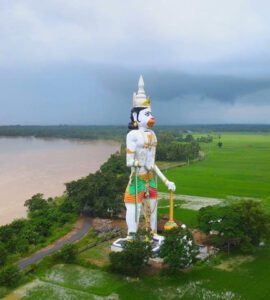
- Location: Madupam, Andhra Pradesh.
- Height: 176 feet.
- Notable Features: The statue stands at the river banks of Vamsadhara.
- History: The statue is believed to be more than a century old.
- Tourist Information: Easily accessible, this site offers prayer facilities and scenic views of the Vamsadhara.
Statue 2: The Anjaneya Swamy Statue
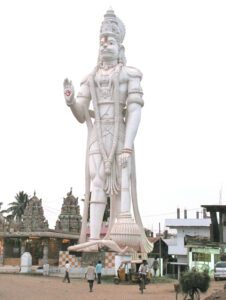
- Location: Paritala, Andhra Pradesh.
- Height: 135 feet.
- Notable Features: Depicts Hanuman holding a mountain, symbolizing his role in the Ramayana.
- History: Established in 2004, this statue attracts many pilgrims yearly.
- Tourist Information: Nearby accommodations make this a great spot for weekend getaways.
Statue 3: Bidangere Hanuman Statue
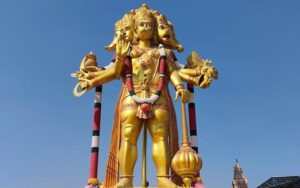
- Location: Kunigal, Karnataka
- Height: 161 feet
The Bidanagere Hanuman statue, also known as the Panchamukhi Anjaneya Swamy statue, is located in the Bidanagere Basaveshwara Mutt, near Kunigal, Karnataka, India. This statue is notable for being the biggest Hanuman statue in the world, standing at an impressive height of 161 feet. It is a golden-hued, five-headed (Panchamukhi) statue of Hanuman, also known as Anjaneya.
The height of the Bidanagere Hanuman statue is approximately 161 feet (49 meters). This makes it one of the tallest statues of Hanuman in the world, attracting many devotees and tourists to the site
Statue 4: Jhakoo Hill Hanuman Temple, Shimla
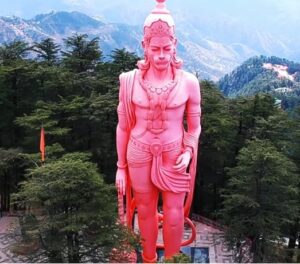
The Jhakoo Hill Hanuman Temple, also known as Jakhu Temple, is a significant Hindu shrine located on the highest peak in Shimla, Himachal Pradesh, India. Here are the key details about the temple:
Location and Elevation
- Location: The temple is situated on Jakhu Hill, which is Shimla’s highest peak.
- Elevation: It stands at an altitude of 2,455 meters (8,054 feet) above sea level.
- Dedication: The temple is dedicated to Lord Hanuman, a revered deity in Hinduism known for his strength, devotion, and loyalty.
- Ancient Origins: It is an ancient temple with a rich history, believed to be a legendary abode of Yaksha, Kinners, Nagas, and Asuras.
Notable Features
- Statue: The temple is home to a 108 feet tall Hanuman statue, which is one of the biggest hanuman statues in the world.
- Surroundings: The temple is surrounded by deodar trees, adding to its serene and spiritual ambiance.
- Accessibility: Visitors can trek up to the temple, enjoying the scenic views of Shimla along the way.
- Pilgrimage: The temple attracts pilgrims and tourists from far and wide, making it a popular destination for both religious and recreational purposes.
- Aarti and Poojas: The temple conducts regular aartis and poojas, which are significant spiritual practices for devotees.
- Panoramic Views: The temple offers panoramic views of Shimla, enhancing its appeal as a spiritual and tourist destination.
The Jhakoo Hill Hanuman Temple stands as a testament to the rich cultural and religious heritage of Himachal Pradesh, attracting visitors with its historical significance, spiritual ambiance, and breathtaking views.
Statue 5: Shri Sankat Mochan Hanuman at Delhi
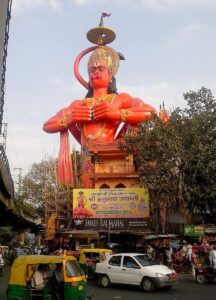
The Shri Sankat Mochan Hanuman Temple in Delhi is a significant Hindu temple dedicated to Lord Hanuman, known as the “Sankat Mochan” or the “reliever of troubles.” Here are the key details about the temple:
Location and Structure
- Location: The temple is located in Karol Bagh, New Delhi, India.
- Height: The temple is 108 feet tall, featuring a cave identical to that of the Vaishno Devi Shrine in Jammu & Kashmir.
- Iconography: The temple houses a 108-foot tall Hanuman statue, which is one of the tallest in the world.
Historical and Religious Significance
- Dedication: The temple is dedicated to Lord Hanuman, who is revered for his strength, fortitude, and unwavering devotion to Lord Rama.
- Founding: The temple was built in 1997 and is known for its spiritual significance and the belief that regular visitors will gain the special favor of Lord Hanuman.
- Devotion: The temple is a place of solace for devotees, who often chant the Hanuman Chalisa and other hymns.
- Activities: The temple conducts regular aartis and poojas, and it is a popular destination for devotees seeking blessings and solace.
- Accessibility: The temple is easily accessible and attracts a large number of visitors, both devotees and tourists45.
- Surroundings: The temple is surrounded by a serene environment, enhancing its spiritual ambiance.
The Shri Sankat Mochan Hanuman Temple in Delhi stands as a prominent place of worship, attracting devotees with its historical significance, spiritual ambiance, and the belief in the divine intervention of Lord Hanuman.
Statue 6: Hanuman Dham Statue Shahjanpur
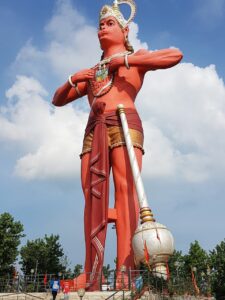
The Hanuman Dham Statue in Shahjahanpur, Uttar Pradesh, is a significant religious and cultural landmark. Here are the key details about the statue:
Height and Significance
- Height: The statue stands at 104 feet tall, making it one of the tallest statues of Lord Hanuman in India.
- World Ranking: It is the third largest Hanuman statue in the world, after the Veer Abhaya Anjaneya statue.
- Location: The statue is located at Visrat Ghat on the Khanaut River in Shahjahanpur.
- Setting: The statue is situated on an island created by two branches of the local river, overlooking the ghat.
Design and Features
- Material and Color: The statue is made of reinforced concrete and is adorned with vibrant colors, particularly orange, which is a traditional color associated with Lord Hanuman.
- Details: The statue features well-defined details, including a grand mace and the figures of Lord Rama and Sita at its heart, adding to its grandeur and spiritual significance.
- Devotion: The Hanuman Dham is a popular pilgrimage site, attracting devotees who seek blessings and solace from Lord Hanuman.
- Tourism: It is also a notable tourist spot, known for its picturesque surroundings and the divine feeling it evokes among visitors.
- Other Idols: Apart from the main Hanuman statue, Hanumat Dham also features other captivating idols, enhancing its appeal as a religious and cultural destination.
The Hanuman Dham Statue in Shahjahanpur stands as a testament to the rich cultural and religious heritage of the region, offering both spiritual solace and a visually stunning experience to its visitors.
Architectural Marvels and Engineering Feats
The construction of these grand statues involves remarkable dedication and skill.
- Materials: Often built from stone, metal, or reinforced concrete, these statues are designed to withstand weather and time.
- Techniques: Advanced engineering methods ensure stability and longevity, combining traditional craftsmanship with modern technology.
Experts in architecture often highlight the challenges faced during construction, such as maintaining scale and balancing intricate details. Many of these statues exemplify unique architectural styles, offering a blend of local culture and national heritage.
Pilgrimage and Tourism: Experiencing the Divine
Visiting these colossal statues serves as a spiritual journey that draws people from all walks of life.
- Spiritual Significance: Many believe that visiting these statues can bring blessings and positive energy.
- Tourism Aspects:
- Accessibility: Most sites are well-connected by roads and public transport.
- Accommodations: Varied options, from budget lodges to luxury hotels.
- Nearby Attractions: Explore local temples, markets, and scenic spots.
When planning a visit, consider the best time of year to experience local festivals and gatherings, enhancing the spiritual experience.
Preservation and Future of these Monuments
Caring for these monumental statues is paramount as they represent more than just art; they are cultural landmarks.
- Conservation Efforts: Various organizations are dedicated to maintaining these statues through regular inspection and repairs.
- Future Relevance: As tourism grows, these statues continue to inspire faith and cultural pride among younger generations.
Educational initiatives aim to inform visitors about the importance of preserving these sites for future generations.
The trend of building large Hanuman statues in India
In recent years, India has witnessed a remarkable trend in constructing large Hanuman statues. This movement reflects both devotion and the desire to celebrate cultural heritage.
These colossal sculptures serve as symbols of strength and faith. They inspire millions who come to seek blessings from Lord Hanuman, revered for his unwavering loyalty and courage.
Local governments and communities often spearhead these projects. The aim is not just religious expression but also economic development through tourism.
Biggest Hanuman statues becomes an attraction point, drawing visitors from across the nation and beyond. Many people travel specifically to marvel at their grandeur.
The cultural significance attached to these statues cannot be overstated. Each one tells a story, connecting past traditions with contemporary society while encouraging unity among devotees.
Controversies surrounding the construction of these statues
The construction of big Hanuman statues has sparked a variety of controversies across India. One major concern involves the allocation of public funds. Critics argue that resources could be better spent on pressing social issues like education and healthcare rather than monumental structures.
Environmentalists have also voiced their concerns. Many statues are built in ecologically sensitive areas, leading to fears about deforestation and disruption to local wildlife habitats. The balance between devotion and environmental responsibility remains a contentious topic.
Additionally, some communities feel sidelined by these projects. In regions where large statues dominate the landscape, smaller temples or cultural sites may be overshadowed or neglected entirely.
Political motivations often come into play as well. Questions arise regarding who benefits from these grand constructions, with accusations of using religious sentiment for electoral gains frequently surfacing in discussions surrounding these monuments
Conclusion
The biggest Hanuman statues in India serve as remarkable symbols of faith, art, and heritage. Each statue tells a unique story of devotion, craftsmanship, and cultural pride. These colossal monuments are not just places to visit; they are gateways to understanding India’s rich spiritual landscape.
Readers are encouraged to embark on a pilgrimage to experience the majesty of these statues firsthand, embracing the profound cultural heritage that India has to offer.
Also Read: Rules for keeping Panchmukhi Hanuman Idol at Home

